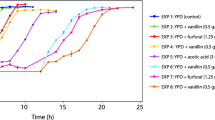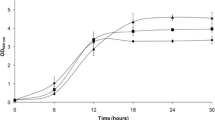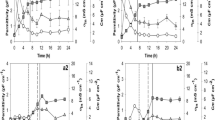Abstract
The long-term action of recommended (RC) and near-recommended concentrations of several commercial biocides (Lonzabac 12.100, Genamin CS302D, benzalkonium chloride and 2-phenoxyethanol) on cells ofS. cerevisiae wild-type strain DTXII was described using plating tests while short-term effects were determined using the potentiometric fluorescent probe diS-C3(3) that detects both changes in membrane potential and impairment of membrane integrity. A 2-d plating of cells exposed to 0.5×RC of benzalkonium chloride and Genamin CS302D for 15 min showed a complete long-term cell killing, with 2-phenoxyethanol the killing was complete only at 2×RC and Lonzabac caused complete killing at RC but not at 0.5×RC. The diS-C3(3) fluorescence assay performed immediately after a 10-min biocide exposure revealed several concentration-dependent modes of action: Lonzabac at 0.5×RC caused a mere depolarization, higher concentrations causing gradually increasing cell damage; benzalkonium chloride and Genamin CS302D rapidly damaged the membrane of some cells and depolarized the rest whereas 2-phenoxyethanol, which had the lowest effect in the plating test, produced a concentration-dependent fraction of cells with impaired membranes. Cell staining slightly increased during the diS-C3(3) assay; addition of a protonophore showed that part of the remaining undamaged cells retained their membrane potential. Comparison of short-term and long-term data implies that membrane depolarization alone is not sufficient for complete long-term killing of yeast cells under the action of a biocide unless it is accompanied by perceptible impairment of membrane integrity. The results show that the diS-C3(3) fluorescence assay, which reflects the short-term effects of a biocide on cell membranes, can be successfully used to assess the microbicidal efficiency of biocides.
Similar content being viewed by others
References
Eminger M., Gášková D., Brodská B., Holoubek A., Stadler N., Sigler K.: Effect of killer toxin K1 on yeast membrane potential reported by the diS-C3(3) probe reflects strain- and physiological state-dependent variations.Folia Microbiol. 44, 283–288 (1999).
Gášková D., Brodská B., Heřman P., Večeř J., Malínský J., Sigler K., Benada O., Plášek J.: Fluorescent probing of membrane potential in yeast: the role of cell wall in assays with diS-C3(3).Yeast 14, 1189–1197 (1998a).
Gášková D., Denksteinová B., Heřman P., Večeř J., Plášek J., Sigler K.: Changes in diS-C3(3) fluorescence in yeast report not only on membrane potential, but also on structural integrity of the plasma membrane, pp. 147–152 inFluorescence Microscopy and Fluorescent Probes (J. Slavik, Ed.). Plenum Press, New York 1998b.
Gášková D., Brodská B., Holoubek A., Sigler K.: Factors and processes involved in membrane potential build-up in yeast: diS-C3(3) assay.Internat.J.Biochem.Cell Biol. 31, 575–584 (1999).
Gášková D., Čadek R., Chałoupka R., Plášek J., Sigler K.: Factors underlying membrane potential-dependent and -independent fluorescence responses of potentiometric dyes in stressed cells: diS-C3(3) in yeast.Biochim.Biophys.Acta 1511, 74–79 (2001).
Gášková D., Čadek R., Chaloupka R., Vacata V., Gebel J., Sigler K.: Monitoring the kinetics and performance of yeast membrane ABC transporters by diS-C3(3) fluorescence.Internat.J.Biochem.Cell Biol. 34, 931–937 (2002).
Hofman T., Wolf G., Koidl B.:In-vitro Untersuchungen über die Wirkung vasokonstriktorischer Nasetropfen auf das Flimmerepithel der menschlichen Nasenschleimhaut.Laryngo-Rhino-Otol. 74, 564–567 (1995).
IFH: Microbial Resistance and Biocides, a review by theInternational Scientific Forum on Home Hygiene. http://www.ifh.homehygiene.org/2public/antresFINAL.pdf; p. 14, September 2000.
Kraft M., Vogel E.: Schnellbestimmung von Benzalkoniumchlorid in Augen- und Nasetropfen der SR 86.Pharmazie 42 (H12), 860–861 (1987).
Krasowska A., Chmielewska L., Gapa D., Prescha A., Váchová L., Sigler K.: Viability and formation of conjugated dienes in plasma membrane lipids ofSaccharomyces cerevisiae, Schizosaccharomyces pombe, Rhodotorula glutinis andCandida albicans exposed to hydrophilic, amphiphilic and hydrophobic pro-oxidants.Folia Microbiol. 47, 145–151 (2002).
Krasowska A., Dziadkowiec D., Lukaszewicz M., Wojtowicz K., Sigler K.: Effect of antioxidants onSaccharomyces cerevisiae mutants deficient in superoxide dismutases.Folia Microbiol. 48, 754–760 (2003).
Moradas-Ferreira P., Costa V.: Adaptive response of the yeastSaccharomyces cerevisiae to reactive oxygen species: defences, damage and death.Redox Rep. 5, 277–285 (2000).
Parsons A.B., Brost R.L., Ding H., Li Z., Zhang C., Sheikh B., Brown G.W., Kane P.M., Hughes T.R., Boone C.: Integration of chemical-genetic and genetic interaction data links bioactive compounds to cellular target pathways.Nature Biotechnol. 22, 62–69 (2004).
Russell A.D., Hugo W.B., Ayliffe G.A.J. (Eds),Principles and Practice of Disinfection, Preservation and Sterilization, 3rd ed., pp. 5–123. Blackwell Science, Oxford (UK) 1999.
Scharff T.G., Maupin W.C.: Correlation of the metabolic effects of benzalkonium chloride with its membrane effects in yeast.Biochem.Pharmacol. 5, 79–86 (1960).
Werner-Washburne M., Braun E.L., Crawford M.E., Peck V.M.: Stationary phase inSaccharomyces cerevisiae.Mol.Microbiol. 19, 1159–1166 (1996a).
Werner-Washburne M., Braun F., Johnston G.C., Singer R.A.: Stationary phase in the yeastSaccharomyces cerevisiae.Microbiol.Rev. 57, 383–401 (1996b).
Author information
Authors and Affiliations
Corresponding author
Additional information
The work was supported by theGrant Agency of the Academy of Sciences of the Czech Republic (grant S5020202), by grants Kontakt CZE 01-032 and ME577 of the German and CzechMinistries of Education and by theInstitutional Research Concept AV0Z 5020 903. The support bySchülke & Mayr GmbH (Norderstedt, Germany) is gratefully acknowledge.
Rights and permissions
About this article
Cite this article
Chládková, K., Hendrych, T., Gášková, D. et al. Effect of biocides onS. cerevisiae: Relationship between short-term membrane affliction and long-term cell killing. Folia Microbiol 49, 718–724 (2004). https://doi.org/10.1007/BF02931555
Received:
Revised:
Issue Date:
DOI: https://doi.org/10.1007/BF02931555




